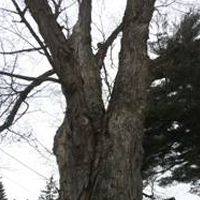Cabling & Bracing Systems
What is Cabling ?
Cabling is installed in trees to provide support to weak or potentially dangerous limbs by connecting two or more limbs together. Additional support may be needed due to split or decayed crotches, crotches with included bark, or inherent danger of weak-wooded trees. Multi-stemmed trees are susceptible to breaking under the stress of wind or the weight of accumulated ice or snow. Branches that pose a potential threat to property or people below may be candidates for cabling.
In determining whether cabling is the right fit for your trees, the condition of the trees are assessed. If the root system is not structurally sound, or if the tree contains excessive decay, removal of the tree may be preferable to prevent property damage or harm to people.
Before installing cables or braces in your trees, the tree should be properly pruned. Hazardous limbs should be removed. If necessary, the tree should be trimmed for balance, and to reduce the weight of the limbs to be cabled. The installation of cabling or bracing is an ongoing responsibility and should be inspected annually. They are checked to see that hardware remains securely anchored. Loose cables may indicate a need for adjustment. As the tree grows older and taller, new cables may eventually need to be installed higher in the tree. Trees that have been cabled should be thinned periodically to remove excess foliage weight and reduce wind resistance.
What types of cabling are there?
There are several different ways to cable tree branches and trees. Each tree has to be assessed and the right method will be chosen by our professionals. The different types are: direct cabling, triangular, box or rotary, and hub & spoke. The materials used are high strength steel cable and forged eye bolts.
What is Bracing?
Bracing is the use of steel rods to provide rigid support for a tree. Bracing is used to reinforce weak or split crotches or strengthen decayed areas on trees. In most cases bracing is used in combination with cabling, not as a substitute.
In many cases it is considered best practice to install more than one bracing rod. Multiple rods provide added strength and reinforcement to a split or weak crotch. If more than one bracing rod is to be installed, they are typically staggered; this is to prevent the formation of decay in the trees.
How do you know if you need cabling or bracing?
There are several things that we take into consideration when determining if cabling and or bracing is necessary in a given tree. If you are able to see decay, cracks, or tight V-shaped branch unions in your trees, it is a good indication that you should contact us to have the trees evaluated.

